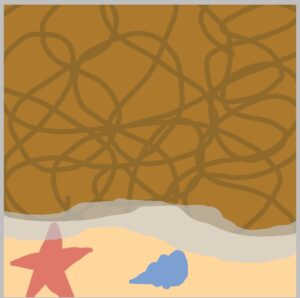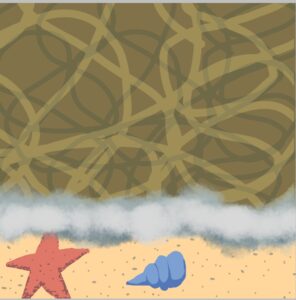Hello. Today, let's add shadow and light to the sandy beach at the sea.
1. Make a rough sketch of the sandy beach

First, make a rough sketch to draw the basic shape of the sandy beach at the sea. In the rough sketch, roughly draw the spread of the sandy beach and the shoreline. Draw the lines lightly and don't get too hung up on the details. At this stage, it is important to roughly capture the topography and texture of the sand. By being aware of the unevenness of the sandy beach and how the sand is gathered at the rough stage, it will be easier to depict the shadows and highlights later.
2. Decide the light source

In order to accurately draw shadows and highlights, it is important to decide the position of the light source. Imagine which direction the sun is shining from and think about the position of the shadow that falls on the sandy beach and where the highlight will be. For example, if the sun is in the upper right, the shadow will fall on the lower left and the highlight will be in the upper right part close to the sun.
3. How to draw shadows on the beach

When drawing shadows on the beach, the key is to draw shadows along the unevenness of the sand. Shadows naturally occur near the mountains of sand and the shore. The color of the shadow should be close to the color of the sand, but a little darker. Use a soft brush to create a gradation so that the shadow gradually fades, resulting in a natural finish. Also, the shape of the shadow should be smooth, and the fine unevenness of the sand should be reflected to increase realism.
4. How to draw highlights

Add highlights to areas where sunlight hits directly and reflects light. It is especially good to add highlights to the shore and areas where the sand is dry, as the grains of sand will look shiny. Use white or bright yellow to express how the surface of the sand is reflecting light. Applying highlights sparingly will make the texture of the sand look natural.
5. Shadows and highlights at the shore

At the shore, pay particular attention to the boundary between the sand and the water.

Areas where the sand is wet due to the influence of the water will be darker than usual, and you can add shadows here as well. On the other hand, strong highlights are needed where the wa ves hit and reflect light. To express the transparency of the water, it is important to make the highlights on the shore clear and smooth.
Summary

Drawing shadows and highlights on the sand of the sea increases the three-dimensionality and realism, making the whole work more attractive. The key to success is to consider the position of the light source and capture the texture of the sand and the characteristics of the shore. By drawing using natural gradations while being conscious of the balance between shadows and highlights, you can express a realistic sandy beach.